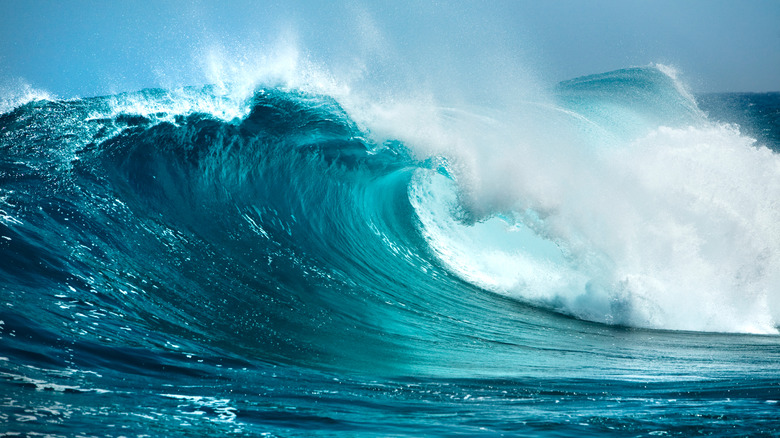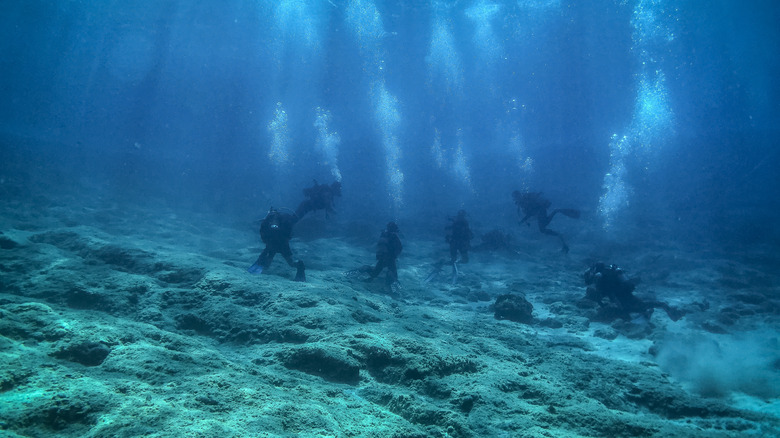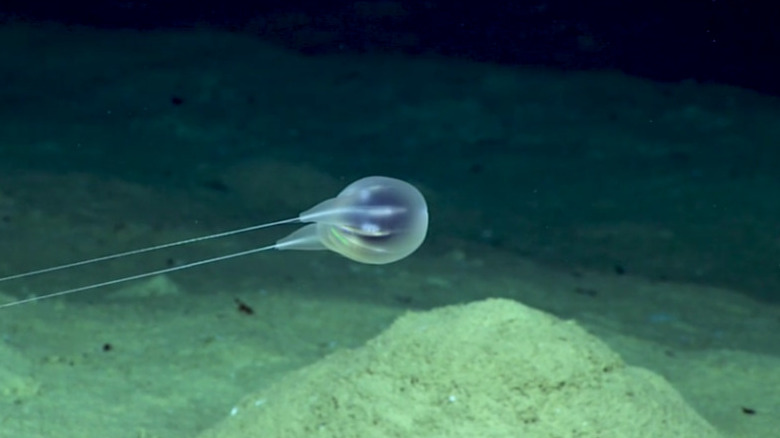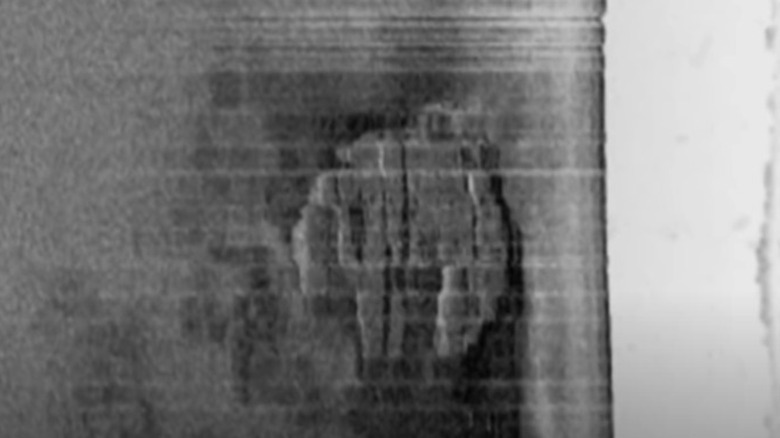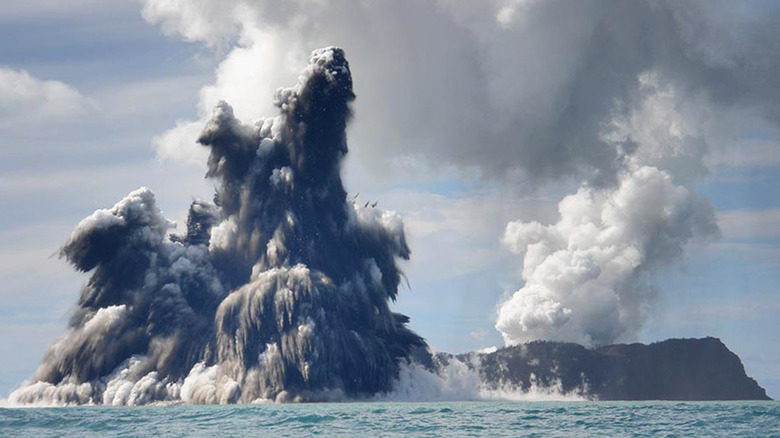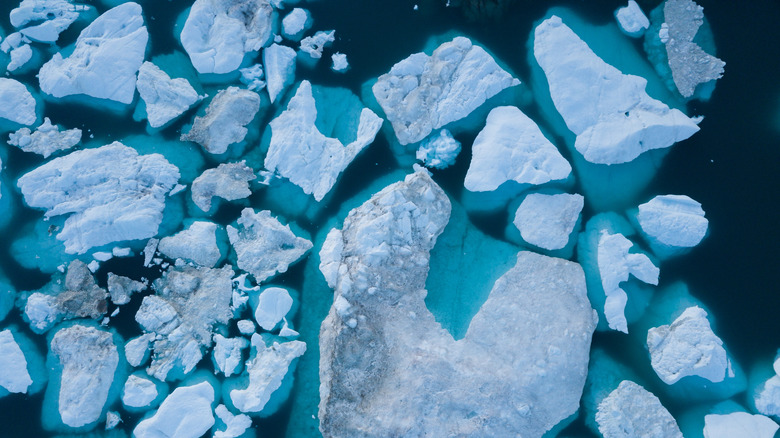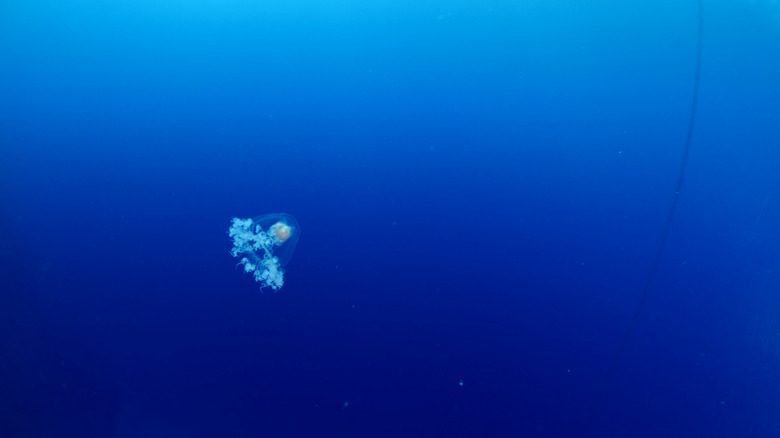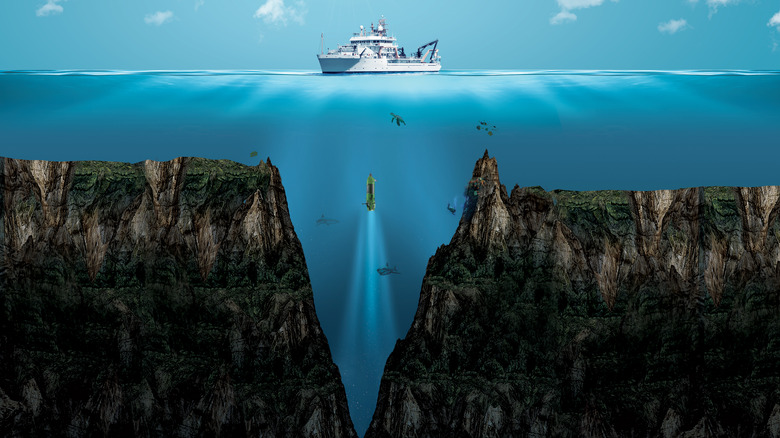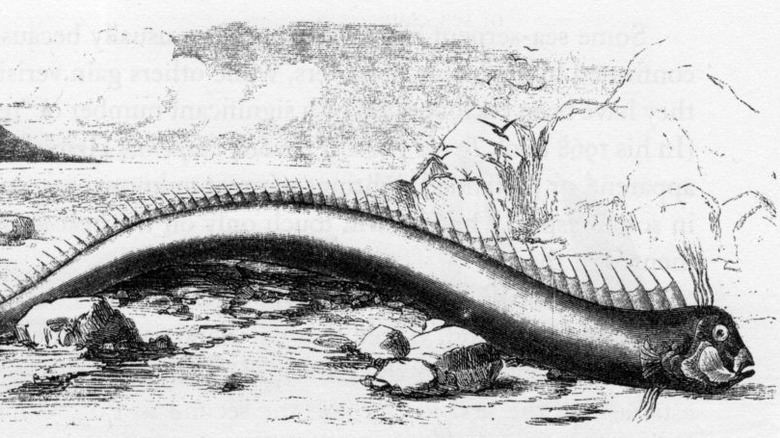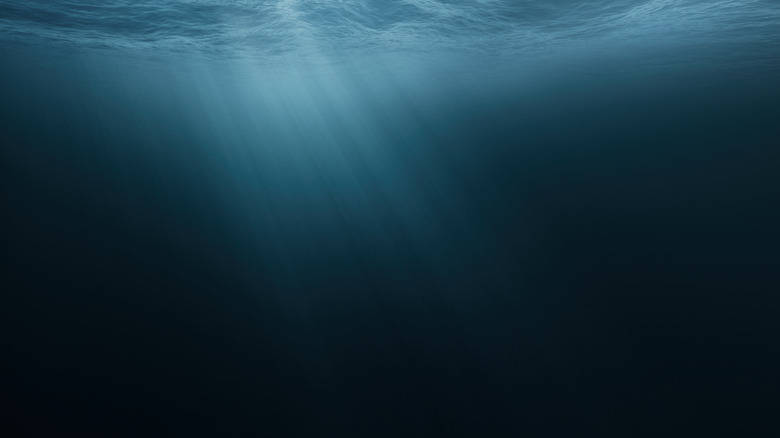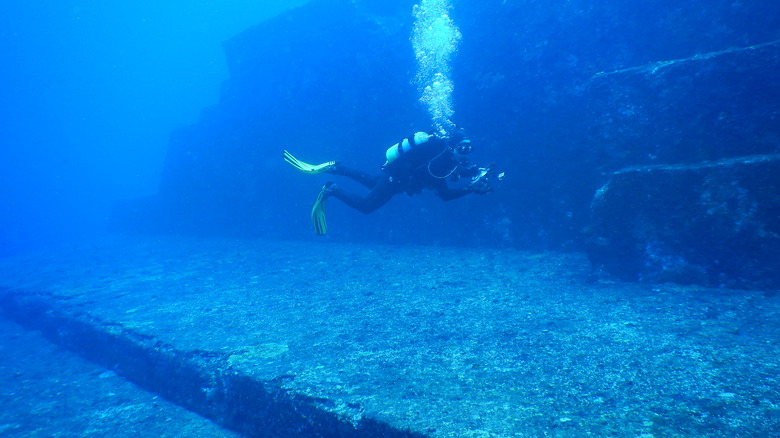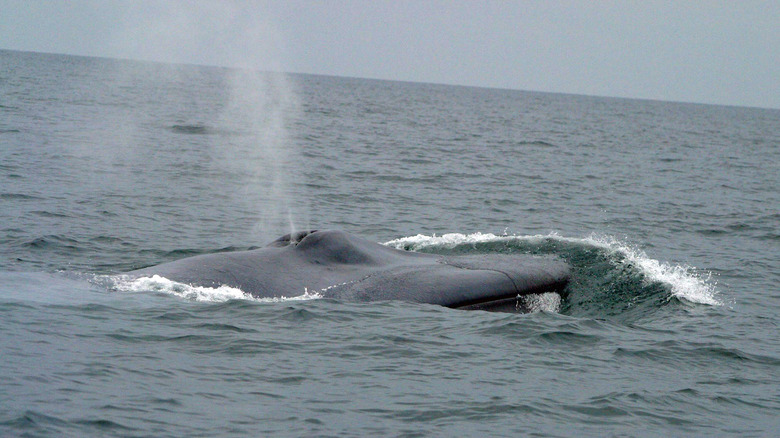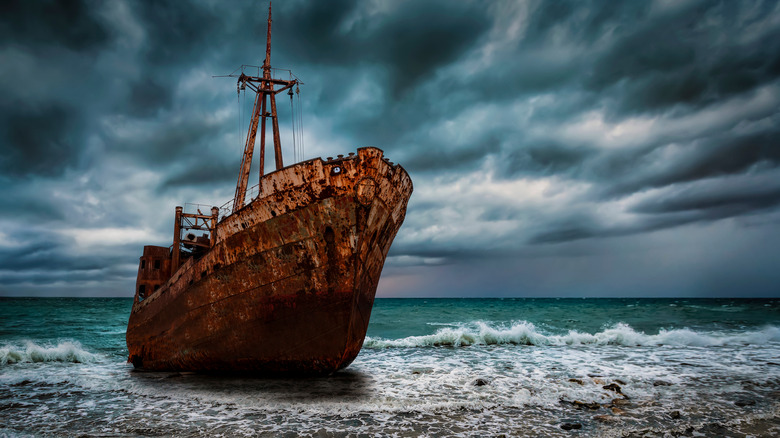Mysteries Of The Ocean You've Never Heard Of
The ocean is vast and endlessly fascinating, particularly since there are so many mysteries surrounding it. Water covers most of the planet, but scientists have only just begun to scrape the surface of what lies on the ocean floor. Nevertheless, scientists are pushing on, discovering new sea species, geologic formations, and even possible alien spacecraft! There are also underwater structures that historians are scratching their heads over, as well as underwater volcanoes that may turn into islands one day.
Researchers have many ways of uncovering the ocean's secrets, one of which is exploring shipwrecks. People have sailed the ocean for thousands of years. The discovery of stone tools from over 10,000 years ago on islands that were never connected to the mainland certainly bolsters the idea that humans have been sailing experts for longer than previously thought (via The Times). There have also been many ocean disasters in history. Explorers look for shipwrecks to see what the ships can tell us about where they came from, where they've been, and where they were going. Exploratory equipment such as submarines and probes is improving, but the ocean still likes to keep her secrets.
The importance of mapping the ocean floor
Scientists don't know for sure what's on the ocean floor, since only around 19% of it has been surveyed and mapped by advanced technology, reports the BBC, as of 2021. Satellites have given scientists some information about the rest of it, since they can carry altimeter technology that infers seafloor topography. For the most part, though, it's a giant unknown.
The ocean depths are necessary to keep track of for many reasons. The ocean floor, which has hills and dips just like a grassy field above the surface, plays a large part in how ocean currents move around the planet. It's necessary to look at how and where the oceans rise, as well as how heat moves around. This helps scientists understand more about how climate change is affecting the earth.
Mapping the ocean floor is also important to keep track of the ocean's biodiversity. The ocean's depths have underwater mountains where wildlife tend to come together. Fisheries management and conservation organizations need to make sure they aren't overfishing some species and underfishing others, notes an article in the Encyclopedia of Ocean Sciences.
According to the BBC, only around 6% of the ocean floor had been surveyed by 2017 when the Nippon Foundation-GEBCO 2030 project was launched. Therefore, scientists assigned to the project still need to survey around 81%, which is, according to project director Jamie McMichael-Phillips, "about twice the size of Mars that we have to capture in the next decade."
New sea species
Since so much of the ocean is a mystery, scientists are constantly discovering previously unknown creatures. Some live solely on the ocean floor, and researchers need to get creative with how they work to study specimens.
Scientists discovered a disco ball-like purple orb off the Santa Barbara coast in 2016, writes The Guardian. It had been clinging to a section of Arguello Canyon, just 5,000 feet below the surface. Luckily, the Ocean Exploration Trust researchers were able to vacuum the orb into storage before a lurking crab made off with the prize. The creature had several features that pointed to it being a mollusk, including a single foot, ear-like rhinophores, and a proboscis, which is a mouth-like organ. Since sea slugs crawl using their one foot, it seems likely that the purple creature is a variant. The vibrant purple color, interestingly, seems to be an effect of the research vessel, and the sea slug doesn't appear to be bioluminescent, noted the researchers.
More recently, in 2020, National Oceanic and Atmospheric Administration (NOAA) researchers confirmed a new species of comb jelly off the Puerto Rican coast. A remotely operated vehicle (ROV) first took video of the creature in 2015. Researcher Allen Collins said, "We didn't have sample collection capabilities on the ROV at the time. Even if we had the equipment, there would have been very little time to process the animal because gelatinous animals don't preserve very well ... High-quality video and photography were crucial for describing this new species" (via NOAA Fisheries).
Possible alien craft in Baltic Sea
According to NBC News, Swedish Ocean X explorers, treasure hunting in the Baltic Sea in 2011, found a large 200-foot-long object that resembled an alien spaceship. Apparently, it looked quite a bit like the Millenium Falcon. Could their discovery have been some kind of alien technology?
Not so fast, said scientists. At the time, researchers thought it was most likely a rare, but natural, geological formation made of pillow basalt. The Ocean X team, including leader Peter Lindberg, detected electrical interference around the object. They reported that "anything electric," including satellite phones, failed when near it — but experts were skeptical. The photograph the team had managed to get was grainy and may have been altered, experts believe. The structure does, however, appear to be made of metal and might be over 140,000 years old, according to Express.
The Ocean X team would be open to further exploration of this possible crashed flying saucer, and a new television project may just give them the opportunity. Lindberg said, "Whatever it is, it is something we do not usually find in nature sitting in the dark cold depths of the Baltic Sea" (via Express).
Underwater volcanoes
Besides the ocean floor, much of the geography of the ocean is still a mystery. There are many possibilities, such as underwater mountains and volcanoes — some of which erupt to create above-surface level islands.
Six underwater volcanoes were discovered in 2019 in the Sicilian Channel, just off the coast of Sicily. Researchers on the OGS Explora were mapping the seafloor of the channel when they came across one of the underwater volcanoes, which was trailing lava for approximately two-and-a-half miles (via National Geographic). All six volcanoes were found within 14 miles of the side of the channel. Imagine how Sicilian residents would feel if they knew there was not one volcano, but six, just a short drive from the beach!
In March 2009, writes National Geographic, the world gained its youngest island from an underwater volcanic eruption in the South Pacific ocean. Tonga is a country made up of 170 volcanic islands, many of which are uninhabited by people. The eruption from the newest piece of land covered the nearby island of Hunga Ha'apai in black volcanic ash that likely stalled its ecosystem for years to come.
South Pacific bloop -- and other sounds
Strange sounds are recorded from the ocean every day. In 1997, scientists in the southern Pacific recorded a loud "bloop" noise. They placed hydrophones, or underwater microphones, far apart in the ocean and ended up recording the sound several times over. Scientists continued to record throughout the next several years, listening for the sounds of underwater volcanoes and earthquakes (via National Ocean Service). It wasn't until 2005 that they discovered the sounds that were heard nearly a decade earlier were an icequake from Antarctica. With increased climate change and global warming, more icebergs are breaking away from Antarctic glaciers to melt into the sea.
Some of these strange noises are still mysteries. The "upsweep" was first recorded in 1991, writes NOAA, and is a series of sweeping tones several seconds long. It has been heard throughout the Pacific Ocean and seems to peak in the spring and fall. This may be because of changes in the source of the noise, or environmental changes. Scientists suspect that it has something to do with underwater volcanoes. Overall, the sound has been declining since 1991 but can still be detected. Scientists still aren't sure precisely what it is, but it has been traced to coordinates between New Zealand and South America.
Immortal jellyfish
The immortal jellyfish, despite being very small at only 3 millimeters in diameter, has the ability to reverse its own aging process. Its immortality comes from its ability to recover from injury and starvation by retreating to the ocean floor and reverting to its youngest stage of life. This ability, called transdifferentiation, isn't fully understood, writes Science Focus. These jellyfish have only been studied sporadically since the 1980s, so scientists just don't have that much data to draw from. Maria Pia Miglietta, head of the Real Immortal Jellyfish project, believes it has something to do with DNA.
As scientists continue to study transdifferentiation, they may find answers about why humans age. "We're far away from any kind of real-world application," says Miglietta. "But we hope that studying what happens in these jellyfish can tell us how their genes change cells — and how these changed cells integrate with others. This is the base of understanding cellular regeneration and tissue regeneration."
Depths of the Mariana Trench
The Mariana Trench is the deepest part of the ocean at nearly 7 miles beneath the surface. It's therefore one of the most dangerous places on Earth, writes the Times of India. The pressure is crushing, sunlight has never hit the bottom, and the temperature is below freezing.
The Mariana Trench clearly has untapped potential for new discoveries of natural adaptations and species. Despite the inhospitable conditions, researchers suspect that hundreds of species make their homes there.
In 2014, scientists discovered a fish (now called the Mariana snailfish) living nearly 5 miles beneath the surface, close to the islands of Guam. The Mariana Trench has such heavy water pressure that it is thought that fish bones — and the calcium inside them — would simply dissolve. It turns out Mariana snailfish have made a slight adaptation to survive. Most fish living near the surface have an additional sac filled with air. The Mariana snailfish have adapted to do without this air sac, so they aren't crushed by the pressure.
Oarfish
Harbingers of doom or sea monsters of old? The mysterious oarfish is known to be both. This serpent-like fish has been described as looking like a giant eel, measuring up to 30 feet in length, and lives deep in the open ocean (via Oceana). They stick to tropical and temperate areas. Their bizarre appearance has led people to suspect that oarfish are related to the sea monster myths of history, writes USA Today.
Oarfish have been found washed up on beaches several times over the past few years, though it's not entirely clear why they become stranded. They are difficult to study in their natural habitat, due to the darkness of the open ocean. Scientists hypothesize that, since they live in areas without currents, and because they lack body mass, they falter near the surface and therefore wind up on beaches. Some people also believe that oarfish becoming stranded on beaches might herald catastrophic events like earthquakes.
Abyssal Zone
Although not nearly as deep as the Mariana Trench, the abyssal zone also has conditions of extreme cold and zero sunlight. It is between 6,600 and 20,000 feet below the surface, and the waters are very calm. The zone contains many nutrient salts like nitrogen, phosphorus, and silica from upper parts of the ocean, which allow life to flourish. The zone is broad, covering around 83% of the world's oceans, writes Britannica.
Newly discovered species in the abyssal zone include some very interesting and ancient protozoans, writes Science Alert. The Clarion-Clipperton Zone (CCZ) covers nearly 2 million miles of the Pacific. It is a rich area for rare minerals and metals, which may lead to mining on the seafloor. Scientists are very interested in the recently discovered single-cell protozoan specimens, called xenophyophores, in the same area and are worried about what mining may do to their environment. Oceanographer Craig Smith says, "Among other things they provide microhabitats and potential food sources for other organisms. We need to learn much more about the ecology [of] these weird protozoans if we wish to fully understand how seafloor mining might impact these seafloor communities."
Japan's Atlantis
In 1987, scientists discovered a strange pyramid-like structure off the coast of the southern Ryukyu Islands of Japan. The structure is a series of carved steps with suspiciously straight edges. Full of arches and right angles, the configuration is believed to be over 10,000 years old, writes BBC. The structure is just one part of an ancient city with pyramids, a castle, temples, and a stadium, reports National Geographic.
Called the Yonaguni Monument and nicknamed Japan's "Atlantis," some think it is the remains of a lost civilization, while others say it's naturally forming. Since the monument is attached to a giant rock mass, it is more likely to be natural — even if people would like to imagine otherwise! Giant's Causeway, in Ireland, has a similar formation of interlocked basalt pieces that was formed by a volcanic eruption. So it's reasonable to assume that the Yonaguni Monument's sharp steps were formed over time by the earthquakes that occur in the area, though researchers don't know for sure.
Blue whales
Blue whales are the largest animals on earth, and despite years of study, marine biologists still don't know as much as they'd like to about them. In 2009, it was discovered that their tonal frequencies have been lowering over the past several decades. Though scientists don't know exactly why, there are a number of possibilities. It may be that the whales are adjusting to more human noise in the ocean, or it may be due to increased salt levels in the oceans. It could also be because there are more whales since the ban on commercial whaling in 1972 (via Ocean Conservation Research). Whales have been vocalizing at a low register, so their songs travel on long wavelengths, which are heard thousands of miles away.
Observing blue whales in their natural environment is difficult, mainly because, since they were nearly hunted to extinction, there aren't very many left to study. Blue whales are extremely long-lived, so it's plausible that some whales remember being hunted. However, advances in technology will bridge some of that gap; satellite tags and high-quality cameras are being used to tag individual whales and follow their paths throughout the oceans. As of 2018, no blue whale breeding grounds have been found (via Geospatial Ecology of Marine Megafauna Laboratory blog).
Cursed shipwrecks
The Gulf of Mexico, writes Mysterious Universe, is estimated to contain over 4,000 shipwrecks. It is a literal treasure trove of shipwrecked glory.
ExxonMobil came across a shipwreck in the Gulf of Mexico in 2003, where they were laying an oil pipeline. Multiple teams of researchers made several attempts to get closer to the ship and pick up artifacts, but everything that could go wrong went wrong. In fact, some believe it may be cursed.
The wreck lay less than a mile below the surface, but even getting to the ship was a challenge for Texas A&M researchers, who tried first. Submersibles discovered that the 65-foot-long ship was a wooden sailing vessel from the 1800s. Scientists then made several attempts to send submersibles down to retrieve objects from the wreck, but equipment began to fail. Researchers did manage to discover that the ship was covered in hand-nailed copper plating, which indicates that it is from the 1800s and was plated to deter insects from eating the wood, writes the New York Times.
Even when the wreck was passed off to other experts, such as Navy research vessel NR1, no one made much progress. The first ROV they put in the water promptly crashed into the side of the ship and destroyed itself. This shipwreck hasn't been properly explored since, and the only artifact researchers have managed to scavenge is a single piece of copper plating. The ocean, it seems, would like to keep this ship's mysteries.
